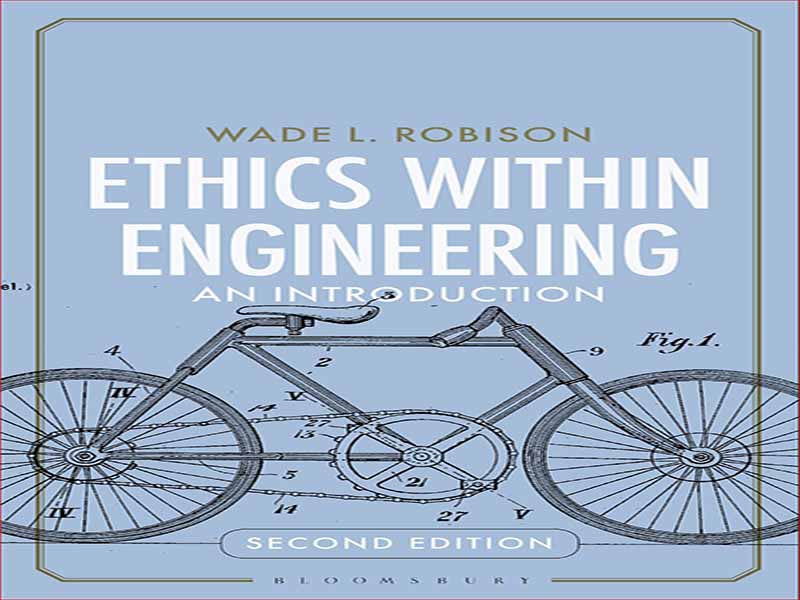- عنوان کتاب: Ethics Within Engineering
- نویسنده: Wadel L Robison
- حوزه: اخلاق
- سال انتشار: 2024
- تعداد صفحه: 257
- زبان اصلی: انگلیسی
- نوع فایل: pdf
- حجم فایل: 8.7 مگابایت
علاقه به اخلاق مهندسی در چند دهه گذشته باعث ایجاد بورس تحصیلی بسیار زیادی شده است. بنابراین هر کسی که در مورد چگونگی ورود ملاحظات اخلاقی به مهندسی می نویسد، مدیون بسیاری است. اما اگرچه از کسانی که در این زمینه نوشته اند چیزهای زیادی آموخته ام، اما به تعداد کمی اشاره خواهم کرد، زیرا روی راهی تمرکز خواهم کرد که در آن اخلاق وارد عمل مهندسی می شود که در ادبیات گسترده ای که اکنون داریم، اگر کاملا نادیده گرفته نشده است، کم اهمیت جلوه داده شده است. . من بر چگونگی ورود ملاحظات اخلاقی به هسته فکری مهندسی، راه حل مشکلات طراحی تمرکز خواهم کرد. مهندسی با یک مشکل طراحی شروع میشود: چگونگی ایمنتر کردن سرنشینان وسایل نقلیه، قرار گرفتن در رابط برای کار با دستگاه اشعه ایکس، طراحی علائم جادهای خواناتر و غیره. هر مشکل طراحی فضای زیادی برای خلاقیت و نوآوری باقی می گذارد و بنابراین طیف راه حل های ممکن برای هر مشکل طراحی خاص گسترده است. ما میتوانیم با نگاه کردن به انواع مختلف ماشینها، توسترها، قهوهسازها یا رایانهها، میزان وسیعی را ببینیم: هر مصنوع یک انتخاب طراحی را نسبت به دیگری نشان میدهد. در انتخاب هر راهحل خاصی، مهندسان باید انتخابهای ارزشی داشته باشند، و بدیهی است، همانطور که با نگاهی به مصنوعات مهندسی مانند خودروها میدانیم، همه انتخابهای طراحی برابر نیستند. هر کدام پیکربندی خاصی از مقادیر را با مجموعه خاصی از جلوهها منعکس میکند، اثراتی که از آنهایی که با به دست آوردن موادی که مصنوع باید از آن ساخته شوند، تا آنهایی که در ساخت تولید شدهاند، تا آنهایی که در انتقال مصنوع به تولید میشوند، متغیر است. بازار و نگهداری آن تا زمانی که به فروش برسد، به کسانی که توسط کسانی که از مصنوع تولید می شوند، و به کسانی که در دور انداختن، بازیافت یا ساخت مجدد مصنوع تولید می شوند، پس از اتمام عمر مفید آن، تولید می شوند. ساده ترین راه برای درک اینکه چگونه ملاحظات اخلاقی وارد مهندسی می شوند، تمرکز بر راه حل های طراحی است که برای کسانی که از مصنوعات طراحی شده استفاده می کنند مشکلاتی ایجاد می کند و واضح ترین نمونه های آن راه حل هایی هستند که حتی باهوش ترین و آموزش دیده ترین افراد را تحریک می کنند. و بیشترین انگیزه را برای اشتباه کردن و گاهی ایجاد صدمات بزرگ دارند – به عنوان مثال، با طراحی یک دستگاه اشعه ایکس که به راحتی می تواند به بیماران یا یک ماشین یا کامیون با خطر انفجار زیاد در صورت ضربه زدن بیش از حد تشعشع کند. همه تابع اصل اخلاقی حداقلی هستند: آسیب غیرضروری نکنید! مهندسان تعهدات ویژه ای دارند تا مراقب باشند که آسیب های غیرضروری به بار نیاورند، زیرا آنها به دلیل مهندس بودن می توانند صدمات زیادی ایجاد کنند و بهترین موقعیت را برای انتخاب راه حل های طراحی دارند که آسیب را به حداقل می رساند. هسته فکری مهندسی، سرچشمه شادی فکری که آن را متحرک می کند، کار کردن با راه حل های مختلف طراحی ممکن و استقرار بر روی یک طرح خاص است که مشکل اصلی را حل می کند و شاید پوشش طراحی را فشار می دهد. در هسته خود، این یک کار اخلاقی است، زیرا پیکربندی خاص اثرات هر راه حل طراحی باعث آسیب بیشتر یا کمتر خواهد شد و به همین ترتیب، همه چیز برابر، کم و بیش اخلاقی است. این مسائل اخلاقی درونی رشته مهندسی است. یک موضوع اخلاقی درونی موضوعی است که در یک رشته مطرح می شود. هیچ کس نمی تواند بدون حل مشکلات طراحی مهندس باشد، و بنابراین هیچ کس نمی تواند بدون اتخاذ تصمیمات اخلاقی که ما باید در حل آن مشکلات بگیریم مهندس باشد. ما باید فرض کنیم که هر رشته ای مشکلات اخلاقی درونی خود را دارد. به عنوان مثال، یک پزشک نمی تواند بدون درمان بیماران به روشی دیگر – با احترام به عنوان یک فرد، یا به عنوان یک ماشینی که باید تعمیر شود – تمرین کند و این دیدگاه های اخلاقی کاملاً متفاوتی است که باید در مورد یک بیمار اتخاذ شود.
An interest in engineering ethics has generated an enormous amount of scholarship over the past few decades. So anyone who writes on how ethical considerations enter into engineering owes much to many. But though I have learned much from those who have written on the subject, I will cite few because I will be concentrating on a way in which ethics enters engineering practice that has been downplayed, if not downright ignored, in the vast literature we now have.
I will concentrate on how ethical considerations enter into the intellectual core of engineering, the solution to design problems. Engineering begins with a design problem—how to make occupants of vehicles safer, settling on the interface for operating an X-ray machine, designing more legible road signs, and so on. Any design problem leaves much room for creativity and innovation, and so the range of possible solutions to any particular design problem is broad. We can see how broad by looking at the various kinds of cars, or toasters, or coffee makers, or computers: each artifact marks one design choice over another.
In choosing any particular solution, engineers must make value choices, and, obviously, as we again know from looking at engineering artifacts like cars, not all design choices are equal. Each reflects a particular configuration of values with a particular set of effects, the effects ranging from those produced by obtaining the material from which the artifact is to be manufactured, to those produced in the manufacture, to those produced in moving the artifact to market and storing it until it is sold, to those produced by those who use the artifact, and to those produced in disposing of or recycling or remanufacturing the artifact once its useful life is completed.
The easiest way to understand how ethical considerations enter into engineering is to focus on design solutions, which cause problems for those who use the artifact embodying the design, and the clearest examples of those are solutions, which provoke even the most intelligent, well-trained, and most highly motivated into making mistakes and sometimes causing great harm—for example, by designing an X-ray machine that can easily over-radiate patients or a car or truck with a high risk of exploding if hit.
Everyone is subject to the minimal ethical principle: do no unnecessary harm! Engineers have special obligations to take care not to cause unnecessary harms because they can cause a great deal of harm by virtue of being engineers and are best positioned to choose design solutions that minimize harm.
The intellectual core of engineering, the source of the intellectual joy that animates it, is the working through of various possible design solutions and settling on a particular design that solves the original problem and perhaps pushes the envelope of design. At its core this is an ethical enterprise since the particular configuration of effects of each design solution will cause more or less harm and so will be, all else being equal, more or less ethical.
These ethical issues are internal to the discipline of engineering. An internal ethical issue is one that arises within a discipline. No one can be an engineer without solving design problems, and so no one can be an engineer without making the ethical decisions we must make in solving those problems. We should presume that every discipline has its internal ethical problems. A physician, for instance, cannot practice without treating patients in one way or another—with respect as a person, or as a piece of machinery to be fixed, say—and those are radically different ethical views to take of a patient.
این کتاب را میتوانید از لینک زیر بصورت رایگان دانلود کنید:
Download: Ethics Within Engineering



































نظرات کاربران